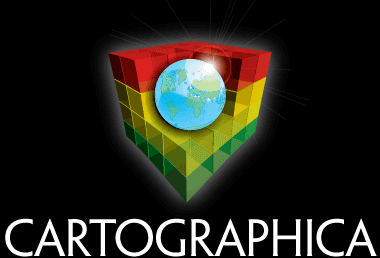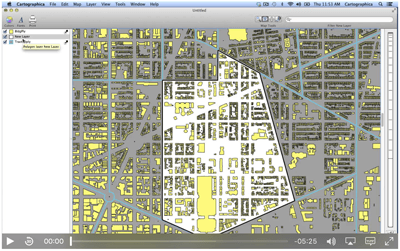Features
Cartographica is full of features to make it easy for you to explore, analyze and present your geospatial data. Here is just a sample of the facilities available in Cartographica.
Flexible File Import

Cartographica has a wide range of data import capabilities, nearly assuring that you can turn your data into maps. Bring in your geo-referenced raster data (like orthophotos and satellite imagery), your vector data from almost any source, or even CSV text files. A more complete list of imported and exported formats is available, including ESRI® File Geodatabase.
Online Map Service Support

There's lots of good data available on the Internet. Getting data from a Web Map Server or Web Feature Server into your map document is a snap. Just load up the area you're looking to cover and select the Map Server. Cartographica will do the rest, from matching the coordinate system to testing the boundaries, to warping the graphics if necessary to meet your current CRS.
If you don't know where to start, just add a Live Map from MapBox™† or OpenStreetMap with one simple command.
Rapid Filtering

This is a Macintosh, and you'd expect fast filtering of data. With Cartographica, you get just that. Using the search box, you can filter on any column. With multi-variable searching and boolean operations you can explore your data even more effectively!
Sophisticated Layout

Cartographica provides sophisticated print layouts, including the ability to put multiple maps on the same page, overlay scale bars, compasses, and legends, or keep them aside, and add text notations. Even have multiple copies of the same map on a page with different zoom levels, extents, and visible layers.
For 1.4, we've added more flexibility and control to Map Layout, including the ability to remove or control borders, and much more control of text formatting and layout.
Flexible Styles

Styles define what layers should look like in a map. Easily put together a simple style based on fill and stroke colors, or create a sophisticated style set for a layer allowing easy identification of features with different attributes. Along with your colors, add labels for features, including data from any column or columns and on multiple lines if necessary.
For 1.4, we've made substantial advances in line and polygon styles, adding patterned and multi-stroke lines for both line features and outlines of polygon features. We've also added pattern fill to polygon features, making it possible to show swamps as clumps of grass instead of just a colored area (for example).
Direct Editing

Need to define geometry for your map without exact coordinates? Cartographica lets you create a new feature, or edit an existing one with ease. Just double-click and move the control points. Styles and related information follow right along. Merge vector features into a single feature–consolidate roads or GPS tracks, join polygons.
Cartographica 1.4 enhances these capabilities further, providing snapping tools to constrain shapes to other layers, or match them up to the existing layer.
Undo Support

We believe that exploring geospatial data should be risk-free. Why should you have to live with every change you make? Cartographica's ubiquitous undo capabilities means whatever changes you've just made... you can undo them... and then put them back.
Layer Transparency

Take advantage of the sophisticated graphics you love on the Macintosh by using transparency to see through one level of data to the next. It is, of course, adjustable on a per-layer (or per-feature basis when you are using complex styles). You can even make a raster layer transparent (or any part of it), in order to enhance visibility of your crucial data.
Simultaneous Data/Map Browsing

Look at your data and map at the same time. Zoom in and filter the map and the data view follows. Scroll around and select features in the data set and they are highlighted on the map. Visualize your data your way. Don't want to give up screen space for the data view? That's fine, just drag it shut, and then open it when you need it again.
Geocoding

Got addresses? Cartographica is the easiest way to put them in their place. With MapBox† Geocoding support and our improved internal Geocoder, you have your choice of easy-to-configure online services, or geocoding using your own data (especially useful if you want to look at historical information). Cartographica will take addresses from lists in text files, tables in databases, or vCards dropped on your map.
Intelligent Projection Management

There's a lot of data available out there, but often each layer is coded with a coordinate reference system that is specific to its producer's own needs. Cartographica understands that, but doesn't let that get in the way of making the data easy to use. Although you can change coordinate systems in existing layers, we'll be just as happy to do the conversions behind the scenes (for raster as well as vector data) in order to make sure your layers match up. And, if we don't have the projection or CRS built-in, you can add it yourself from another map or by importing a CRS in Proj4 or WKT format.
Geospatial Analysis

Cartographica 1.5 expands Cartographica's analysis capabilities to the Raster formats as well. Building on the already-strong foundation of the Vector analysis tools in Cartographica by adding Elevation analysis tools and improved contouring. Our existing Kernel Density Analysis, Buffers, Convex Hulls, Cluster (Hot Spot) Analysis, spatial joins, and spatial overlay operations. These powerful tools make it even easier to explore and manipulate data.
Image Georeferencing

Cartographica helps you to georeference (or edit the georeferencing information for) imagery. Georeferencing can be done with a standard matrix, or by adding or changing Ground Control Points (GCPs).
For 1.5, we've added a new multi-pane georeferencing tool which makes it easy to georeference images using a reference image, such as online maps or another georeferenced image. With this new tool, it's just a matter of a few clicks to georeference your image.
Easy Navigation

Cartographica can remember where you like to look and take you back there. Do you commonly deal with geospatial data in the same places? Cartographica can bookmark areas and viewpoints (a combination of the area and scale) to take you back to where you want to look regardless of which may you are using. Use these to quickly move to known place on a map, or reposition a Map Layout view.
Direct Database Access

Is your source data stored in a database? Cartographica can load data directly using ODBC (the standard for database exchange) and geocode it, join it to existing table data based on keys, or just import it as points with X and Y or latitude and longitude. No more multi-step processes and complex multi-program importing.
GPS Support

If you need to load up field data from a variety of GPS devices, go no further than the File menu. Using the GPS import modules tested over the last three years in our free LoadMyTracks software, we can import waypoints, routes, and tracks directly from hundreds of devices, including those from: Garmin®, Magellan®, Lowrance®, Sony®, and others. And, if your device isn't directly supported, it can import the data using GPX files (the standard for GPS information).

